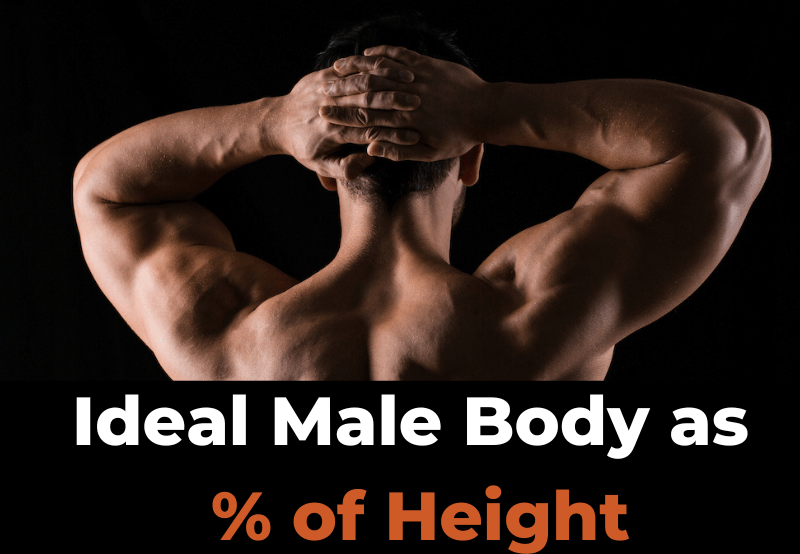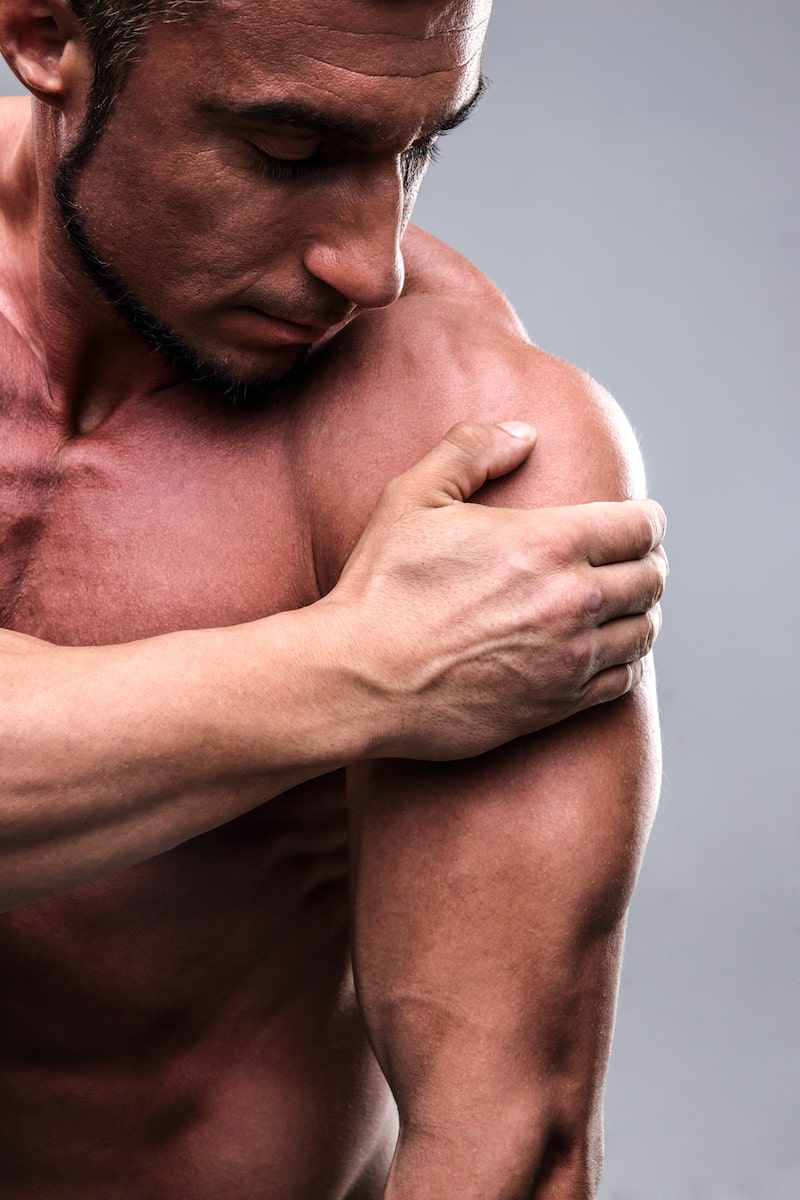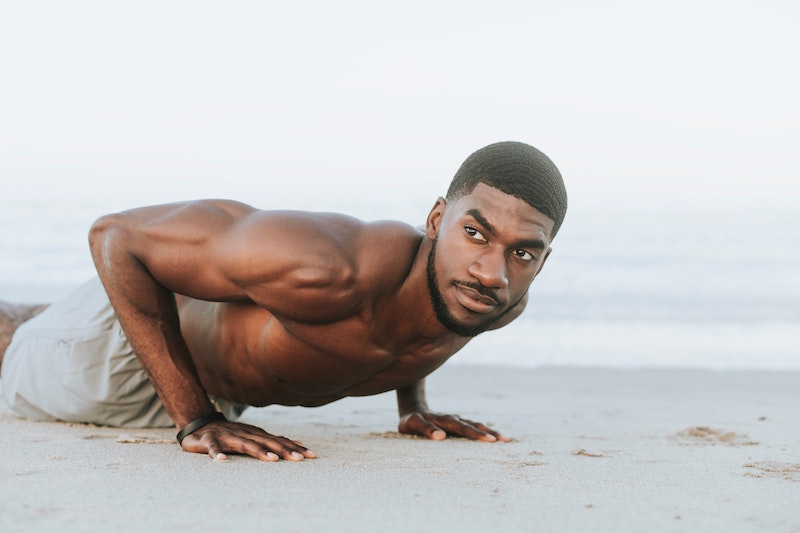The quest for the “perfect” body is almost as old as time itself.
Michelangelo’s statue of David, for example, was once considered the pinnacle of the male form.
Though we now live in the age of “bigorexia” where so many guys want the biggest muscles they can possibly get, many of us chase something much more proportionate:
A lean, athletic, powerful, and chiseled physique.
So how do you get it? And how do you know when you’ve got it?

According to multiple sources, the ideal male body measurements are:
- Waist – 45-47% of height
- Shoulders – 1.618x waist
- Arms – identical size of neck circumference
- Chest – 10-12″ greater than waist
These are based on a sub-10% body fat percentage and a solid amount of muscle mass, usually achieved after at least a few years of training.
Let’s take a deeper look at the perfect male body measurements (according to height), and how to achieve these ideal measurements.
To achieve these standards, you might need to lose fat, build muscle, or both.
If you like to do things on your own, read on!
A quick note on being body positive:
There’s really no such thing as the ‘perfect body.’
You know that, right?
There is research that indicates what other people (and women) respond to in terms of physical attraction, and there are bodybuilding standards, but objective perfection is not a real thing.
Love your body the way it is, strive to improve, and enjoy the journey!
Okay, moving on.
Lean & tight waist (ideal waist size = 45-47% of height)
Waist size is the building block of a great physique. Too much extra padding around the middle, and the entire aesthetic suffers.
A waist size of about ~45% of your height indicates fairly low bodyfat percentage and an overall athletic build (also, probably a nice set of abs).
Example: If you’re 5′ 10″, the ‘ideal’ waist size would be around 31-33″
How to get a lean waist: Diet! Men tend to store most of their fat in their upper body, around their midsection in particular, so you’ll need to lose a significant amount of fat to get a tight waist and reveal your abs.
Here’s the basic blueprint:
-
Eat in a moderate calorie deficit to lose fat
-
Lift heavy weights to preserve or build muscle
-
Do some direct ab work for definition
(For an awesome diet and training program that’ll help you drop about a pound of fat per week and get shredded fast, check out Greg O’Gallagher’s Kinobody Warrior Shredding Program — hit the link for my hands-on review & results after trying the program myself!)
Broad shoulders (ideal shoulder size = 1.618x waist)

Broad, powerful shoulders are a hallmark of masculine physiques. They indicate strength and confidence, along with an abundance of testosterone.
A shoulder width of just over one and a half times your waist size will make your upper body pop, and help give you that coveted v-shape.
Example: For a 5′ 10″ man, the ideal shoulder width would be about 51-53″
How to get broad shoulders: Unlike getting a slim waist, you’ll have to build significant amounts of strength and muscle in your upper body to separate yourself from the pack.
The basics:
-
Get strong on overhead presses and other shoulder pressing movements
-
Add in extra volume by isolating the front, side, and rear delts (shoulder muscles)
-
Stay lean!
(I highly recommend the Kinobody Greek God Program and nutritional protocol for packing on muscle while staying lean — hit that link to see what happened when I tried this lean bulking program myself.)
Wide back (ideal back size)
A highly overlooked muscle group for getting the perfect male body, the back is actually the true key to the V-shape.
Wide lats (the back muscles that rest under your rear shoulder) can give your torso a striking, powerful appearance. They’ll also be super functional for keeping you healthy and strong in real life.
There’s no specific proportion that can be applied to your back muscles, but they should be in proportion to your shoulders and help contribute to the overall wideness of your upper torso.
How to get a wide back:
-
Build strength on vertical pulls (weight pull ups are best) to hit your lats hard
-
Add thickness to your back with rows and horizontal pulls
Thick upper chest (ideal male chest size = 10-12″ wider than waist)

Big shoulders and a wide back are the foundations of the V-shape that helps make up the perfect male body, but without a powerful chest to go with it, the proportions will be all off.
Your chest won’t necessarily give you a ton of extra width to your frame, but will give you thickness from the side and make your waist and stomach area look even smaller. The upper chest in particular forms a powerful looking shelf when built properly.
Example: For a 5′ 10″ tall guy, a chest measurement of about 42-45″ is ideal, assuming a lean and tight waist in the low 30″ range.
How to get a well-developed chest & upper chest:
-
Build strength on the incline bench press to really target the upper chest and shoulders
-
Flat bench and weighted dips can be used, as well
(A 225lb bench press is a really nice milestone to keep in mind when you start lifting. If you’re wondering about how long it’ll take you to reach that level, start here for my best estimation based on a ton of research.)
Well-developed arms (ideal arm size for men = same size as neck)
Everyone wants huge, muscular arms, but your frame can only handle so much based on your height. A good number to shoot for, in terms of impressive and well-proportioned arms, is the same circumference of your neck.
You’ll want your biceps and triceps to be equally strong and well-developed for the best results, as well as staying lean to reveal plenty of definition.
Example: For the average 5′ 10″ man, building his arms up to about 15.5-16.5″ (typical neck size) should look great.
How to get great arms:
-
Focus on building tremendous strength on the key compounds lifts already mentioned: incline bench press, weighted pull ups, and other major push/pull movements
-
Add extra volume to your biceps with various curls, and to your triceps with pushdowns, skullcrushers, and other isolation moves
A lot of guys shoot for “17-18 arms as the gold standard, which is close to the natural limit for most men.
However, this may not be achievable or even look particularly good on a man of smaller stature.
Proportional legs (ideal male leg size)
The ideal male body doesn’t have massive tree-trunk legs, nor does it have skinny, chicken legs.
There’s no ideal proportion here or ideal male thigh size, but the goal should be athletic legs with solid muscle size and explosive strength.
How to get well-developed but proportional legs:
-
Hit lots of one-legged movements (split squats, lunges, pistol squats) to get well-developed quads
-
These moves will also help your VMO (the teardrop shaped muscle above your knee) pop, which looks great
For reference, a lot of the classic bodybuilders had leg measurements of around 27″.
You might consider this your ideal, but for non-bodybuilders you may want to go with a leaner and more proportionate measurement.
(By the way, if you’re having trouble with soreness or not being able to walk after leg day, I put together some killer tips you have to try before, during, and after your next lower body workout!)
Wrapping Up
Let’s finish up using some examples.
What are the perfect measurements for a 5’7″ male according to these standards?
The ideal physique for a 5’7″ man would feature around a 41″ chest and a 30-31″ waist.
The ideal physique for a 5’10” man would feature around a 43″ chest and a 31-32″ waist.
Once again, there’s no true “ideal” body, but there are some standards based on the scientific study of attraction, as well as general bodybuilding best practices.
Everybody’s body and goals are different, so don’t let these confine you. Hopefully, these measurements will inspire you to reach your best physique possible.
And here’s a quick bonus, in case this is relevant to you!
What are the ideal bodybuilding measurements & how is bodybuilding judged?
In competitive stage bodybuilding — which is just one type of fitness competition — it’s less important to strive for a specific measurement than you might think.
In other words, bigger isn’t always better.
(Though, yes, overall mass is one of the key judging standards.)
Bodybuilding judges, however, also factor in a contestant’s:
- Proportion
- Symmetry
- Definition
- And stage presence
Proportion: All things in proportion!
Major lagging muscle groups in competitive bodybuilding is a huge no-no.
It’s awesome to have a “specialty” muscle group, like incredible shoulders, but not at the expense of something else like your back or arms.
Give proper attention to each part of your body, even smaller muscle groups.
Symmetry: This one is a little bit harder to quantify, and definitely harder to achieve.
Some people are blessed genetically with amazing symmetry in their face, body, and muscles. Others just aren’t.
However, you can tweak your routine to help create the illusion of a more symmetrical physique.
According to Bodybuilding.com, focus on the:
- Abs
- Shoulders
- Calves
- Forearms
- And outer back or lats
Extra calf and forearm training sounds a little unorthodox!
But these are key and highly visible muscle groups that can throw your whole physique out of whack if not properly developed.
Definition: What you may lack in size you can always make up for in definition or tone.
In most cases, the leaner and more shredded you can get, the bigger you’ll look.
So if adding more mass to, say, your chest or back seems to be an issue for you, you may be able to make up ground in the definition area by achieving a leanness that bigger competitors can’t.
Stage presence: This is a much bigger deal than most people give it credit for!
If your physique and proportions are great but not the best on stage, you can always dazzle the judges with:
- Your smile
- Great poses
- Knowing your angles
- Oozing charisma
Don’t overlook this key aspect of your training. In addition to gym time, you should be practicing for the stage, as well.
What are some measurements of famous bodybuilders with ideal bodies?
Steve Reeves, at his peak, who was 6′ 1″:
- Arms: 18.5 inches
- Calves: 18.5 inches
- Thighs: 27 inches
- Chest: 54 inches
- Waist: 30 inches
Arnold Schwarzenegger, who was 6’3″:
- Arms: 22 inches
- Calves: 20 inches
- Thighs: 28.5 inches
- Chest: 57 inches
- Waist: 30 inches
Question: Arms should be the same as neck size. Is that comparison using the arm size when flexed or when forearm is extended? Pretty significant difference for a lot of guys between flexed/not flexed. Thanks!